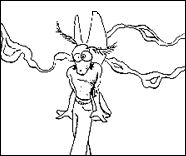
These compelling scents announce a variety of behaviors beyond reproductive readiness. Pheromones can also signal starvation in bacteria and some worms, fear in cockroaches, and readiness to march in army ants. Even plants use pheromones to signal when they have been damaged by grazing.
Since pheromones are so important to other animals, researchers have searched for human equivalents. Dr. Louis Monti-Bloch, an associate professor of psychiatry at the University of Utah, has unearthed several pheromones from human skin. Some evoke a feeling of well being in both men and women, while others do the opposite.
His work has not gone unnoticed. Several perfume companies - such as Erox - have used pheromones with different effects in men and women to create a perfume they claim will be biologically irresistible to the opposite sex. But not all perfumes advertising as pheromonally based actually contain pheromones. "There is a lot of baloney out there in the market," says Monti-Bloch.